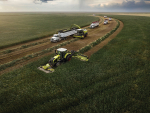It is more challenging than ever. We must produce more with less, we must be more environmentally conscious, we must continue to improve the way we farm our animals and we must come to grips with growing competition from new markets.
There’s been a huge change in the way New Zealand’s goods are now positioned. Our brand has shifted to a higher cost, higher quality product aimed at a more discerning international consumer. Retailers are meeting this demand by being ethically and environmentally responsive.
And this plays to New Zealand’s strengths when it comes to primary production.
An innovative and prosperous rural sector is at the heart of our economic growth agenda.
The primary sector now makes up 71% of New Zealand’s total merchandise export trade - but not to the countries we once relied on.
The changing face of farming has paralleled a change in our traditional export markets.
The EU, the world’s largest economic trading bloc, faces major challenges as it deals with countries like Greece, Italy and Spain. The US can at best be described as subdued.
In the past, this would have had a huge impact on New Zealand. After all, these were once our main export markets.
Though such markets are still very important to us, we are fortunate to have repositioned ourselves so significantly to Asia. China is now our second largest trading partner, with exports growing by nearly 40% in the last financial year, a stunning example of the success of our Free Trade Agreement.
As a nation that trades internationally for its very survival, we know the importance of market access for all our exports.
We are in talks with eight Trans-Pacific Partnership countries, with Russia, India and South Korea – striving to negotiate FTAs beneficial to all New Zealand exporters.
I have just returned from Russia where we are progressing free trade negotiations which began in 2010.
Two-way trade is currently worth about $700 million - but if a deal is reached, it will be Russia’s first international trade deal and our exports will grow significantly.
One of the things that stood out to me during my trip was how highly regarded New Zealand is internationally.
We are well known as producers of some of the best food in the world, at a time when food security is the world’s greatest challenge. The overarching challenge for New Zealand is to protect its reputation as a quality producer.
We need to play to our strengths and protect the brand that sets us apart from our competitors.
New Zealand’s physical distance from markets is unique among developed countries and this presents us with a clear challenge.
No other country in the OECD has such a striking combination of small size and remoteness.
But this shouldn’t be viewed as a negative.
As a nation whose economy depends on the powerhouse of our primary industries, New Zealand’s global focus must remain on maximising our reputation for producing high quality products, backed by integrity.
Our farmers and growers are among the world’s most innovative and efficient.
They are fully embracing the changing face of farming. But we must continually strive to find ways to work smarter, to deliver greater prosperity and opportunity to all New Zealanders.








